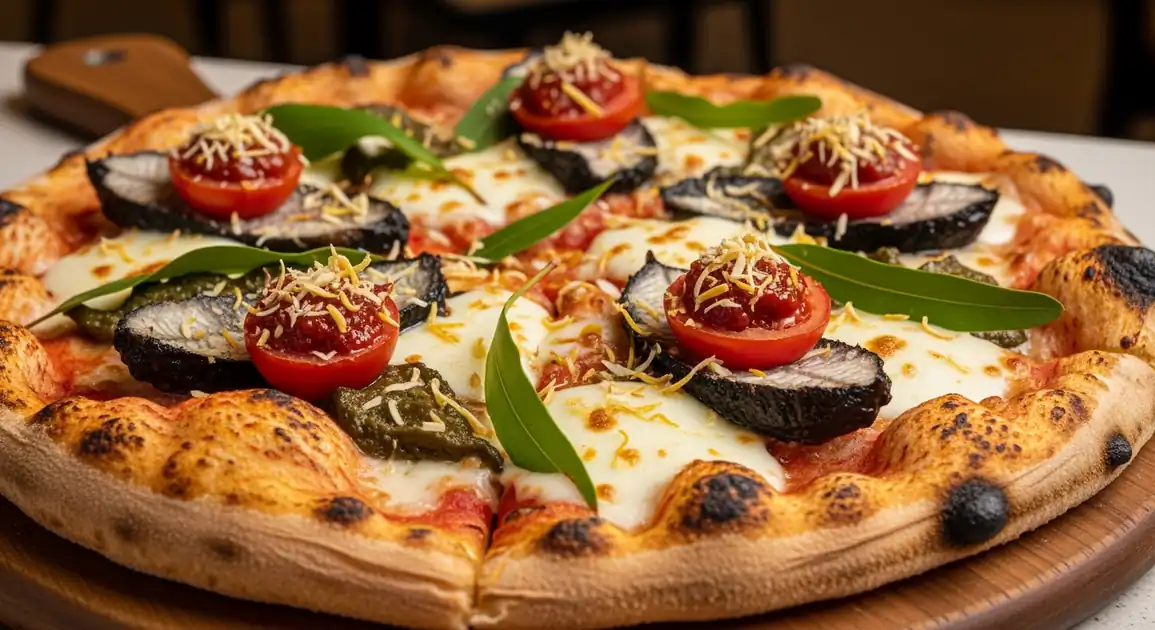Bush Tucker Pizza
Bush Tucker Pizza

Description
Bush Tucker Pizza is a niche but growing part of Australia's culinary scene, representing the Modern Australian movement's embrace of native ingredients. It's not found in standard pizzerias but rather in specific restaurants, cafes, and catering services aiming to provide a unique Australian food experience, particularly in major cities and tourist destinations.
Dietary Information
Serving information
Serving style
Served like a standard pizza, usually uncut or pre-sliced, on a plate or wooden board. Often presented as a gourmet item.
Quick facts
Restaurant lunch (12 PM - 3 PM) and dinner (6 PM - 10 PM) hours.
Safety Tips
What to Look For
-
Reputable restaurant or caterer
Choose established businesses known for quality and adherence to food safety standards, especially when dealing with game meats and native plants.
-
Pizza cooked thoroughly and served hot
Ensures all ingredients, including meat and cheese, are heated to safe temperatures.
-
Fresh appearance of ingredients
Vegetables and greens should look vibrant, not wilted or old. Meat should look properly cooked.
-
Transparency about ingredients
Good establishments should be able to inform you about the specific native ingredients used and potentially their sourcing.
What to avoid
-
Questionable hygiene standards at the venue
Avoid any place that appears unclean, increasing the risk of general foodborne illness.
-
Pizza that is lukewarm or seems reheated
Increases risk of bacterial growth.
-
Ingredients that look old, wilted, or discolored
Indicates lack of freshness and potential spoilage.
-
Cross-contamination concerns (if allergic)
If you have severe allergies (e.g., nuts often used in kitchens), confirm preparation practices regarding shared surfaces and utensils.
Price information
Price range
Budget tips
- Prices reflect the often higher cost and specialized sourcing of native ingredients. Expect mid-range to premium pricing.
- Lunch specials at restaurants might offer a more affordable tasting opportunity.
- Sharing a pizza can be more economical.
Value indicators
- Use of multiple, distinct native ingredients.
- Clear explanation of ingredients on the menu or by staff.
- Good balance of flavors – unique but palatable.
- Quality pizza base and overall preparation.
Where to Find This Dish
Major City CBDs & Dining Precincts
Restaurants focusing on Modern Australian or fine dining in city centers are most likely to offer it.
Sydney CBD, Melbourne CBD, Brisbane South Bank
Dinner, Lunch
Tourist Hubs
Areas heavily frequented by tourists might have restaurants showcasing native foods.
The Rocks (Sydney), Uluru (Ayers Rock) resort restaurants
Lunch, Dinner
Specialty Cafes/Restaurants
Look for venues explicitly advertising use of native ingredients or Aboriginal culinary experiences (modern context).
Dedicated native food cafes/restaurants
Lunch, Dinner
Vendor Tips
- Check restaurant menus online beforehand to confirm they offer Bush Tucker Pizza or similar native dishes.
- Be adventurous but ask staff about unfamiliar ingredients if unsure of flavors.
- Consider restaurants that partner with Indigenous communities or suppliers for ethical sourcing.
How to Order
Regional Variations
-
Kangaroo Pizza
(Kangaroo Pizza)
Features kangaroo meat (mince, sausage, or fillet strips) as the primary native topping, often paired with bush tomato relish or native herbs.
-
Emu Pizza
(Emu Pizza)
Highlights emu meat (smoked, sausage, or fillet strips), typically paired with complementary native flavors like quandong or lemon myrtle.
-
Vegetarian Bush Tucker Pizza
(Vegetarian Bush Tucker Pizza)
Omits meat, focusing on a variety of native plants, fruits, and vegetables like warrigal greens, bush tomatoes, quandongs, saltbush, and native herbs.
-
'Coat of Arms' Pizza
('Coat of Arms' Pizza)
A colloquial name sometimes used for pizzas featuring both kangaroo and emu meat, referencing the Australian Coat of Arms.
-
Lemon Myrtle Chicken Pizza (Fusion)
(Lemon Myrtle Chicken Pizza)
While chicken isn't native, this popular fusion uses lemon myrtle to flavor chicken toppings, sometimes presented alongside other bush tucker elements.
Cultural context
History
The concept of Bush Tucker Pizza emerged relatively recently, likely from the late 20th century onwards, coinciding with the broader Modern Australian cuisine movement's interest in exploring and incorporating native ingredients. It represents an attempt by non-Indigenous chefs and businesses to showcase unique Australian flavors to a wider audience, moving beyond traditional preparations. It is important to note this is a contemporary fusion dish, distinct from traditional Indigenous foodways, though inspired by the ingredients central to them.
Local significance
Represents a contemporary engagement with Australia's Indigenous food heritage by the wider culinary scene. Sparks conversation about native ingredients and food sovereignty.
Eating customs
- Eaten like any other pizza, usually shared.
- Appreciated for its novelty and unique flavor combinations.